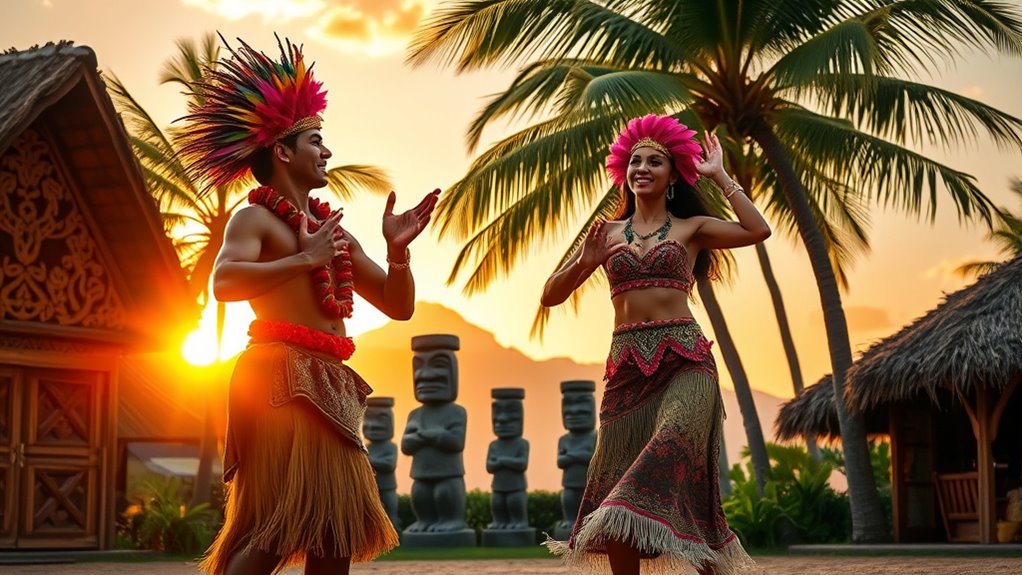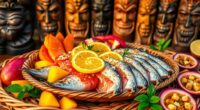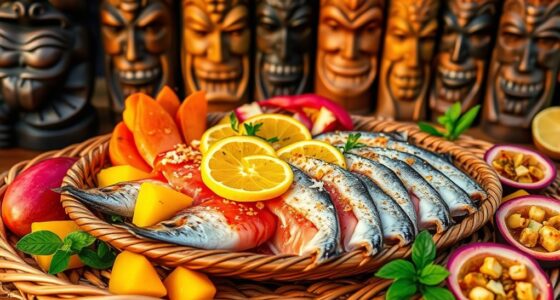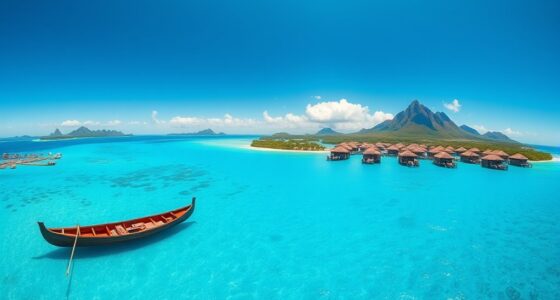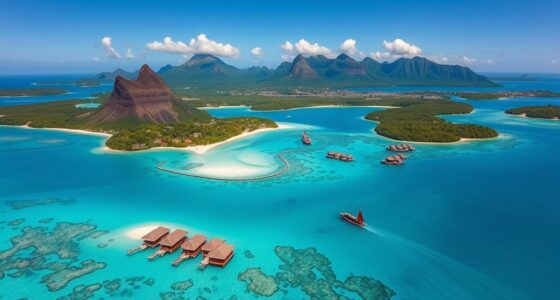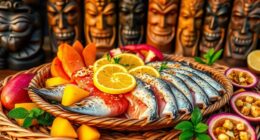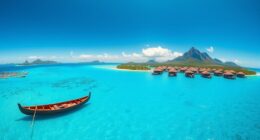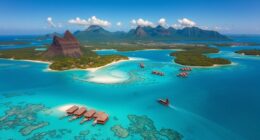Polynesia’s history begins with daring voyages from Southeast Asia and Melanesia around 1100-1200 CE, using star and ocean navigation. You’ll see how the Tongan Empire expanded across the Pacific before European explorers arrived and transformed local societies. Their rich arts, customs, and social hierarchies reflect a deep cultural legacy, which persists today amid modern independence efforts. To explore how these traditions evolved and shaped contemporary life, keep exploring further.
Key Takeaways
- Polynesians pioneered advanced ocean navigation and colonized vast islands across the Pacific, establishing rich societies and cultural traditions.
- The Tongan Empire’s rise and decline shaped regional politics, social hierarchies, and cultural legacies still evident today.
- European exploration introduced new technologies and caused significant cultural upheavals, including land loss, religion shifts, and disease.
- Indigenous arts like carving, tattooing, and weaving reflect social status, spiritual beliefs, and storytelling, integral to Polynesian identity.
- Modern Polynesian cultures preserve traditional practices like dance, navigation, and arts, blending them with contemporary influences and political developments.
Early Polynesian Migrations and Settlement Patterns
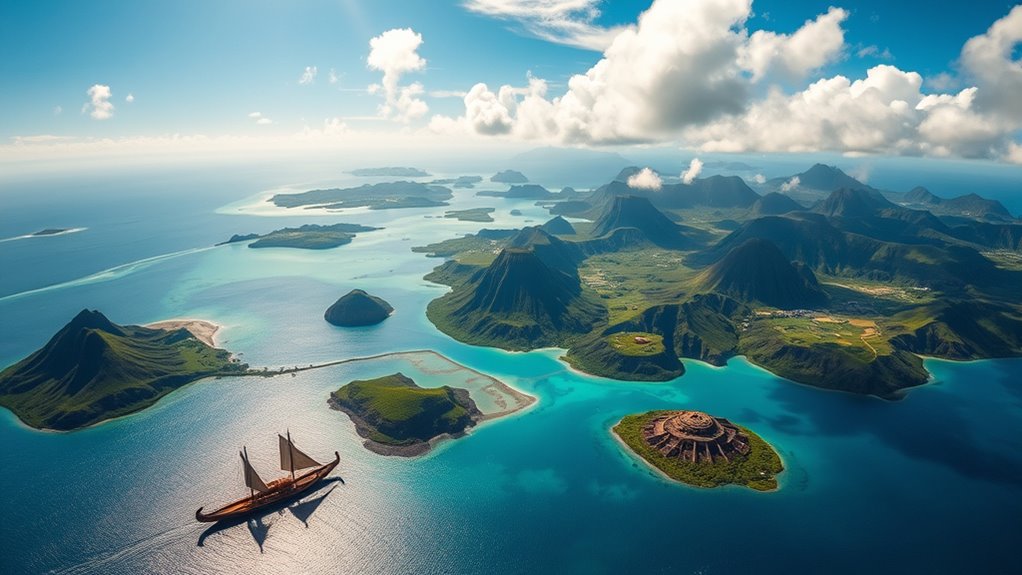
Polynesians began their remarkable migration across the Pacific around 1100–1200 CE, moving from their original homeland in Southeast Asia and Melanesia. You would have traveled aboard double-hulled canoes, relying on navigation skills that used stars, ocean currents, and bird patterns. Your journey took you to the Tuamotu Islands, where you settled around this time, establishing communities and adapting to island life. From Tahiti and Ra‘iātea, you expanded further, reaching Aotearoa (New Zealand) by about 1200 CE, showcasing your remarkable seafaring capabilities. Evidence suggests you even voyaged to South America, indicating that your navigation skills extended over vast distances. These migrations laid the foundation for the diverse and complex Polynesian societies that would flourish across the Pacific. The development of sophisticated navigation techniques played a crucial role in enabling these long-distance voyages.
The Rise and Fall of the Tongan Empire
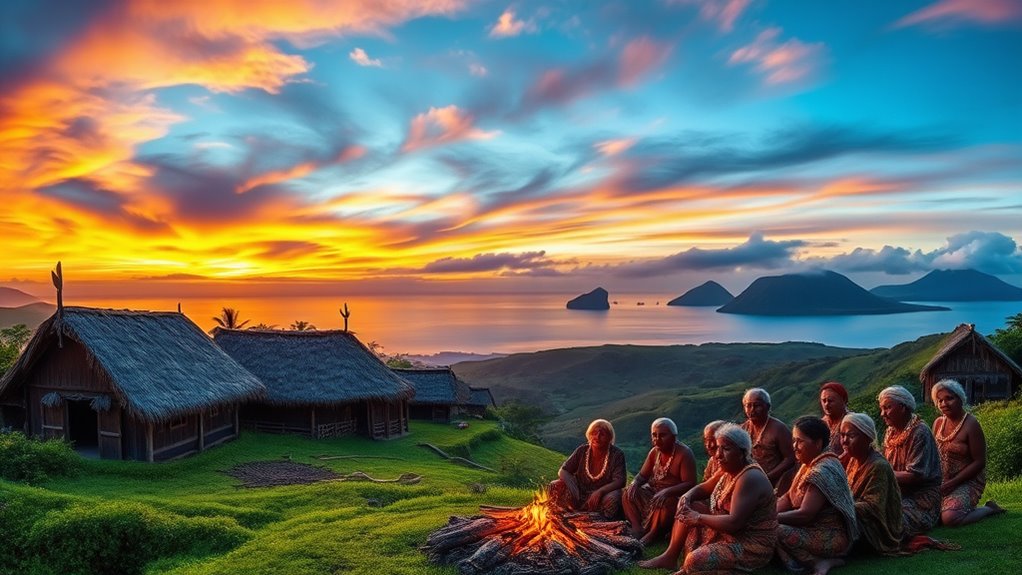
The Tongan Empire once expanded across much of Polynesia, establishing regional dominance through strong leadership and strategic alliances. As power shifted and internal conflicts arose, the empire’s influence declined, leading to political realignments and the loss of its former reach. Today, remnants of Tongan culture and its imperial legacy still influence the region, highlighting its historical significance. The empire’s symbolic representations continue to serve as cultural markers that reinforce identity and pride among Polynesian communities.
Tongan Empire Expansion
Between 1200 and 1500 CE, the Tongan Empire rapidly expanded its influence across much of Polynesia, establishing itself as a dominant maritime power. You would have seen Tongans extending their reach through skilled navigation, powerful fleets, and strategic alliances. They asserted control over nearby islands like Samoa and Fiji, spreading their political and religious practices. The Tuʻi Tonga rulers, such as Tuʻi Tonga Momo and Tuʻi Tonga Tuʻitātui, consolidated power, transforming Tonga into a regional hub. You’d notice their influence in cultural exchanges, trade routes, and religious customs. This expansion boosted Tongan prestige and solidified their dominance in the Pacific. However, this growth also set the stage for political rivalries, shifting control, and, eventually, decline as external and internal pressures grew. Maritime navigation played a crucial role in their successful expansion and dominance.
Political Decline Shifts
As the Tongan Empire reached the height of its power, internal conflicts and external pressures gradually chipped away at its dominance. You see, political stability eroded due to succession disputes and rising regional rivals. External forces, like European explorers and colonial powers, challenged Tonga’s independence and influence. These shifts led to significant changes:
- European colonization efforts weakened traditional authority structures.
- The signing of treaties, such as the 1900 Anglo-Tongan agreement, limited sovereignty.
- Tonga’s strategic position made it vulnerable to foreign interference, culminating in its protectorate status under Britain.
Cultural Legacy Remnants
Despite its decline, the Tongan Empire’s cultural legacy still shapes the identities and traditions of Polynesia today. You can see its influence in regional art, dance, and social structures, which emphasize hierarchy and respect. The iconic Tuʻi Tonga titles and leadership concepts continue to inspire leadership ideals across Polynesia. Tongan traditions, such as elaborate kava ceremonies and intricate tattooing, remain fundamental cultural practices. Architectural styles, like the fale (traditional houses), reflect Tongan craftsmanship and social organization. Additionally, the empire’s ocean voyaging skills have inspired navigational techniques used by Polynesian navigators today. While political power waned, the empire’s spiritual beliefs, social customs, and maritime expertise persist, reinforcing a shared Polynesian cultural identity rooted in Tongan history. Moreover, the influence of WWE Raw’s Financial Impact highlights how cultural expressions can evolve and adapt within modern entertainment and media landscapes, demonstrating the enduring legacy of traditional values in contemporary society.
European Exploration and Encounters in the Pacific
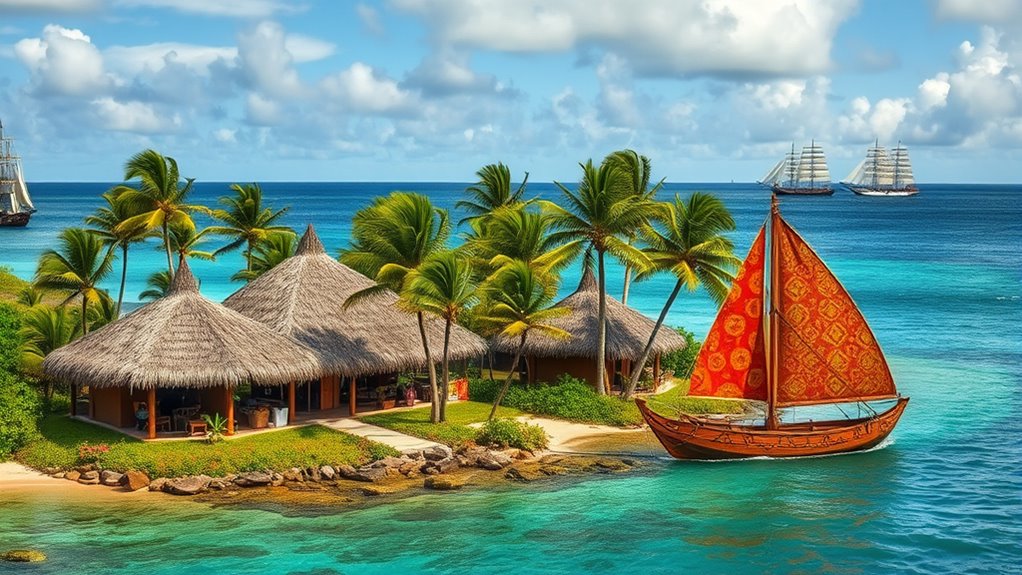
When European explorers like Magellan, Tasman, and Cook arrived in Polynesia, they changed the course of history. Their encounters introduced new technologies and ideas but also brought upheaval to indigenous societies. These interactions left lasting impacts on Polynesian cultures and political landscapes. Additionally, some of these voyages contributed to the development of Volkswagen Tuning, as innovations in engineering and mechanics spread through the exploration of new territories.
Early European Navigators
European navigators first entered the Pacific in the early 16th century, marking the beginning of documented European encounters with Polynesia. You’ll see their ships stretching across vast ocean stretches, driven by curiosity and the desire for new routes. These explorers brought new maps, technologies, and ambitions, transforming Pacific navigation.
- Ferdinand Magellan’s fleet arrived in 1520, opening the Pacific to European exploration.
- Álvaro de Mendaña sighted islands near Tuvalu in 1568, expanding European awareness.
- Abel Tasman reached New Zealand in 1642, providing detailed European knowledge.
Their voyages laid the groundwork for future exploration, navigation, and colonial ambitions. As a result, Polynesia became a key focus for European powers seeking trade routes, territorial claims, and scientific knowledge.
Impact on Indigenous Societies
The arrival of European explorers in the Pacific profoundly altered the lives and social structures of indigenous Polynesian societies. You might notice how traditional leadership roles shifted as outsiders imposed new political systems and borders. Indigenous communities faced violence, land loss, and the disruption of their customs, often replaced by colonial administrations. Missionaries introduced Christianity, leading to widespread religious change and the suppression of ancient beliefs and practices. Contact with Europeans also brought new diseases, decimating populations who had no immunity. Economies transformed as Europeans introduced new goods and trade networks, often undermining traditional subsistence strategies. The introduction of unique and wicked planters also influenced the aesthetics of indigenous environments, blending traditional flora with new species. Despite these upheavals, Polynesian societies adapted, blending old traditions with new influences, ensuring their cultures persisted and evolved under changing circumstances.
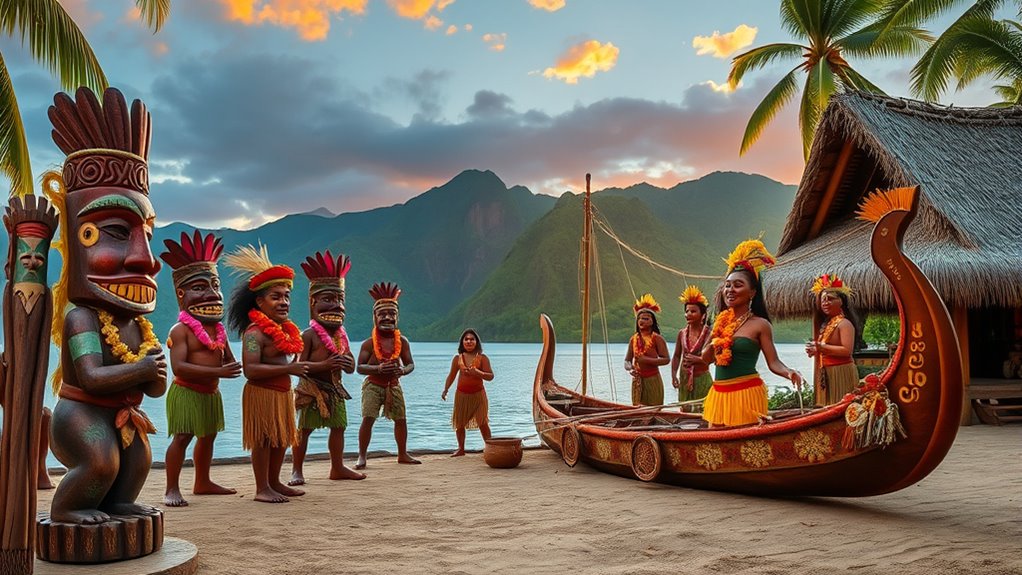
Indigenous Polynesian societies developed complex social structures rooted in hierarchical chieftainships and kinship networks that organized communities and maintained social order. These structures determined leadership roles, land rights, and social responsibilities. You’ll find that chiefs, or aliʻi, held significant authority, often linked through kinship to reinforce political stability. Cultural practices centered around community cohesion, ocean navigation, and ancestral reverence. These social systems were often supported by rituals and traditions that strengthened social bonds and cultural identity.
Traditional Arts, Crafts, and Artistic Expressions
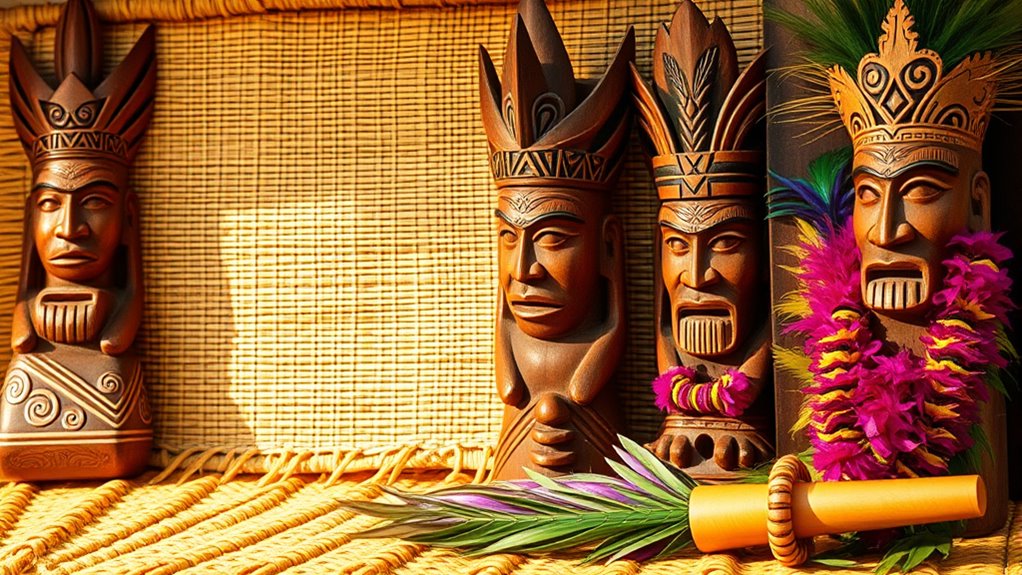
You’ll find that Polynesian art is rich with carving and sculpture techniques used to create both functional and ceremonial objects. Textile and barkcloth art showcase intricate patterns and methods passed down through generations, reflecting cultural identity. Body art, especially tattooing, serves as a powerful expression of social status and personal history ingrained in Polynesian traditions. Additionally, traditional arts often emphasize color accuracy to ensure that patterns and motifs are vividly and accurately represented, preserving their cultural significance.
Carving and Sculpture Techniques
Polynesian carving and sculpture techniques embody a rich tradition of artistic mastery that reflects their cultural values and spiritual beliefs. You’ll find that artisans use tools made from volcanic stone, shell, and bone to shape wood and stone into meaningful objects. These carvings often serve both decorative and ceremonial purposes, embodying ancestral spirits or deities. You might notice the intricate patterns and symbolic motifs that tell stories or convey social status. To deepen your understanding, consider these aspects:
- Use of natural tools like adzes and chisels crafted from volcanic rock
- Incorporation of geometric patterns and stylized figures
- Techniques like relief carving and hollowing to create complex textures
- The symbolic significance of specific motifs and their role in storytelling and cultural identity
These methods reveal a deep connection between Polynesians and their environment, blending function with spiritual significance.
Textile and Barkcloth Art
Have you ever marveled at the vibrant barkcloth and textile arts that Polynesian communities create? These arts hold deep cultural significance, often symbolizing status, identity, and spiritual beliefs. You’ll find that traditional barkcloth, called tapa, is made by pounding bark from trees like fig and mulberry, then decorating it with intricate patterns using natural dyes. Textile arts, including weaving and embroidery, use fibers from pandanus, coconut, and other plants to craft clothing, mats, and ceremonial objects. Patterns often tell stories, honor ancestors, or represent social rank. These crafts are passed down through generations, reflecting Polynesia’s rich cultural history. Today, they continue to thrive, blending traditional techniques with contemporary expressions, maintaining an essential link to Polynesian identity and heritage.
Tattooing and Body Art
Did you know that traditional Polynesian tattooing is a powerful form of cultural expression that conveys identity, social status, and spiritual beliefs? When you see Polynesian tattoos, you’re witnessing stories etched into skin—marks of heritage, rank, and personal achievements. These tattoos often cover large areas of the body, like the face, chest, or limbs, symbolizing protection and spiritual power.
The designs incorporate geometric patterns, ocean symbols, and ancestral motifs that tell personal and collective histories. Tattooing involved specialized tools like bone or shark teeth, applied with ink made from natural ingredients. The process was sacred, often performed during important life milestones, reinforcing community bonds and individual identity.
This art form remains a crucial link to Polynesian history and spiritual life, serving as a form of emotional support that strengthens cultural pride and personal resilience.
Religious Beliefs and the Impact of Christian Missionaries

How did the arrival of Christian missionaries transform the traditional religious landscape of Polynesia? When missionaries arrived in the 19th century, they dramatically altered existing beliefs by challenging and often destroying indigenous idols, temples, and sacred sites. They promoted Christianity, converting many locals quickly, and built churches that became central to village life. You’d see traditional practices suppressed or hidden, replaced by Christian rituals and moral codes. Missionaries also introduced education and literacy, shaping social values and governance. Despite this, some Polynesians blended Christian teachings with their ancestral beliefs, creating hybrid spiritual practices. Over time, Christianity became deeply embedded in Polynesian societies, influencing art, ceremonies, and daily life, while indigenous religions persisted in concealed or evolved forms. The impact reshaped cultural identity across the islands, often at the expense of older spiritual traditions.
Colonial Era Transformations and Political Shifts
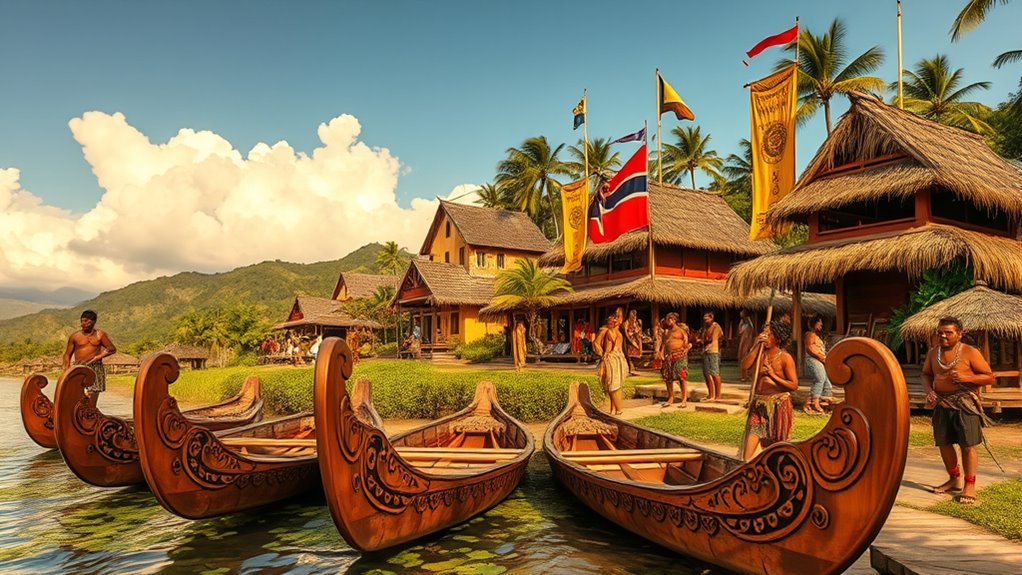
The arrival of European powers in the 19th century dramatically reshaped Polynesian political landscapes, as colonial authorities established control over many islands. You’ll see that these shifts led to the decline of traditional monarchies and the rise of new governance structures. Colonial powers imposed new laws, altered land ownership, and integrated islands into global trade networks.
- Many islands became protectorates or colonies, losing their independence
- Treaties, like the Treaty of Waitangi, formalized British sovereignty but caused tensions
- Islands such as Hawaii and Tahiti experienced monarchy overthrow and French annexation
These changes disrupted social structures, suppressed indigenous authority, and introduced Western political ideals that continue to influence Polynesian nations today.
Key Islands and Regional Variations in Polynesia
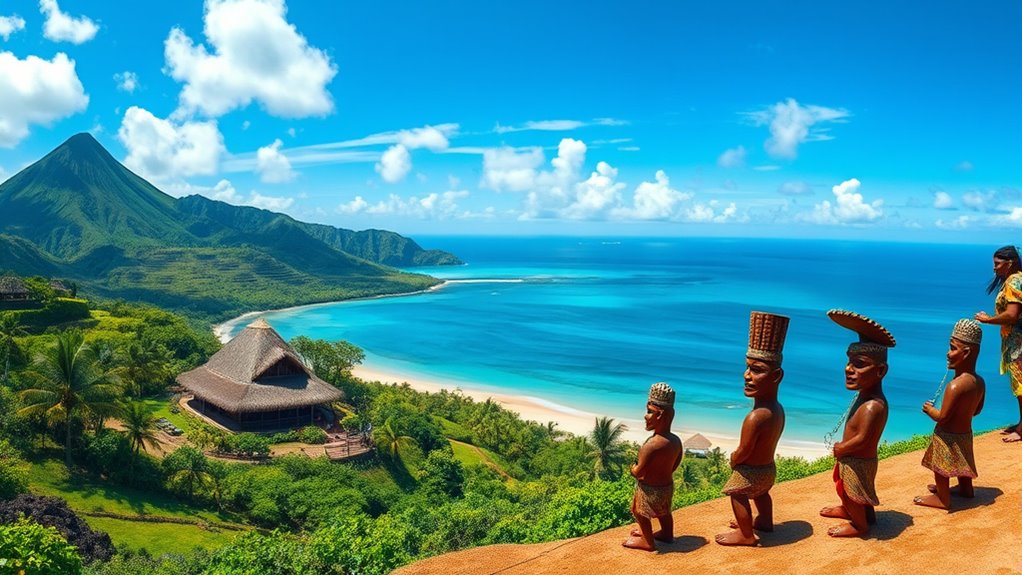
Polynesia’s diverse geography is reflected in its key islands and regional variations, each with unique histories, cultures, and political developments. You’ll find Tonga, a long-standing monarchy that maintained independence longer than many neighbors, with a centralized leadership shaping its identity. Hawaii stands out for its kingdom’s rise under Kamehameha I, its encounters with explorers like Captain Cook, and later US annexation. Fiji’s Lau Islands experienced shifting dominance between Tongan and Fijian rulers before unification under Seru Epenisa Cakobau. Niue, with its Polynesian roots, developed a distinct dialect and experienced late European contact, initially resisting outsiders before adopting Christianity. Tahiti, influenced by early French contact and missionary activity, became a cultural hub. These islands showcase the rich regional tapestry that defines Polynesia’s complex historical landscape.
The Evolution of Language and Cultural Connections
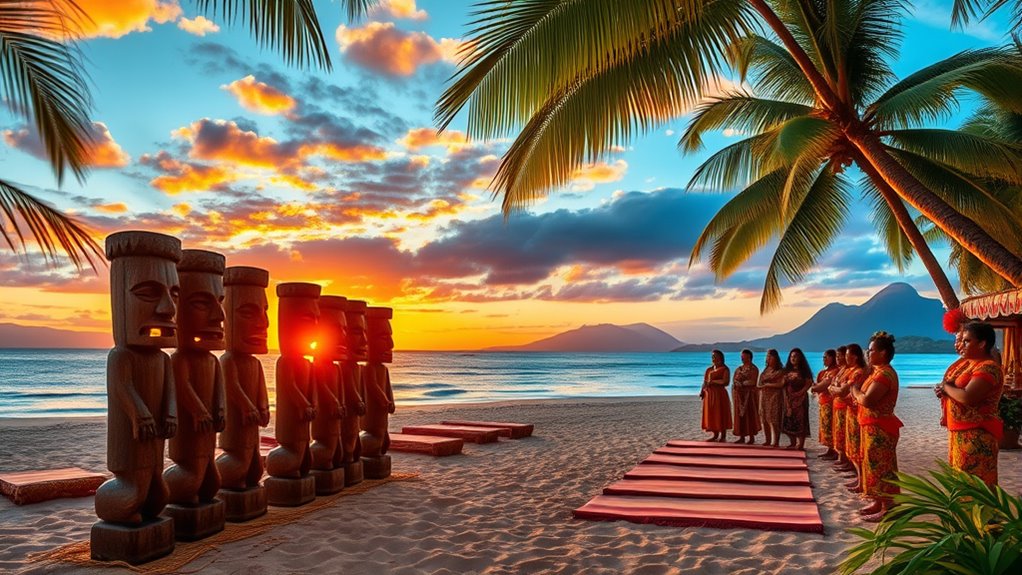
As Polynesian societies migrated across vast ocean distances, their languages evolved through both shared roots and regional influences, creating a complex web of cultural connections. You can see this in similarities among languages like Samoan, Tongan, and Niuean, which trace back to a common ancestral language. Over time, regional dialects developed, shaped by isolation and contact with neighboring islands. This linguistic evolution reflects their navigation skills and cultural exchanges. You might notice:
- Shared vocabulary and grammatical structures across Polynesian languages
- Borrowings from neighboring regions, such as Melanesian influences
- The preservation of core words despite regional dialect differences
These linguistic ties demonstrate how voyaging and interaction fostered a unified yet diverse cultural landscape across Polynesia.
Modern Polynesia: Autonomy, Independence, and Contemporary Life

Modern Polynesia experiences a dynamic balance between maintaining traditional cultures and embracing new political realities. Many islands have gained varying degrees of autonomy or independence, shaping their contemporary lives. Some, like Tonga, remain largely independent, while others, like New Zealand and French Polynesia, operate under colonial or territorial frameworks. You’ll find that each island navigates its unique path, balancing cultural preservation with modern governance. The table below highlights key political statuses:
| Island/Region | Political Status | Recent Developments |
|---|---|---|
| Tonga | Independent Kingdom | Maintains monarchy, modern reforms |
| Samoa | Independent Republic | Strengthening local governance |
| French Polynesia | Overseas French Territory | Autonomy with French oversight |
| Niue | Self-governing in free association | Deepening cultural revival |
Despite political shifts, cultural traditions like dance, art, and ocean voyaging thrive, enriching contemporary Polynesian life.
Frequently Asked Questions
How Did Polynesians Navigate Vast Ocean Distances Before Modern Technology?
You navigate vast ocean distances by relying on sophisticated traditional methods. You use the stars as guides, memorizing their positions and patterns to determine direction at night. You observe ocean currents, wind patterns, and bird behaviors to find land or favorable routes. Your knowledge of these natural signs, combined with experience passed down through generations, allows you to voyage accurately across enormous distances without modern technology.
What Are the Lasting Impacts of Colonization on Polynesian Languages and Cultures?
You see that colonization has deeply affected Polynesian languages and cultures. Many native languages, like Niuean, face decline due to European influence and the dominance of colonial languages such as English, French, and Spanish. Cultural practices, including traditional arts and religions, often blend with Christianity or fade altogether. Colonial powers also imposed new governance systems, altering social structures and disrupting indigenous ways of life, leaving lasting impacts on identity and heritage.
How Did Indigenous Religions Influence Polynesian Societal Practices Before Christianization?
You might think Christianity replaced everything, but indigenous religions deeply shaped Polynesian society before that. You’d find gods, spirits, and rituals woven into daily life, guiding everything from fishing to leadership. Sacred sites and carvings weren’t just art—they held spiritual power. Even with colonization, many practices persisted in secret or hybrid forms, proving that Polynesian faiths left an indelible mark on their cultural identity, despite efforts to erase them.
In What Ways Do Polynesian Societies Maintain Their Cultural Identities Today?
You can see Polynesian societies maintain their cultural identities today through language preservation, traditional arts, and ongoing rituals. Many communities celebrate ancestral stories, dance, and music, keeping their heritage alive. You’ll find that tattoos, carvings, and crafts still hold cultural significance. Indigenous practices blend with modern life, fostering a strong sense of community and pride. These traditions help Polynesians honor their history and pass cultural values to future generations.
What Role Did Women Play in Traditional Polynesian Political and Social Structures?
Women in traditional Polynesian societies held roles so powerful, it’s like they were the heartbeat of culture and politics. They often led families, influenced chiefs, and even participated in rituals that shaped entire communities. Their wisdom guided decisions, and some societies believed women’s voices could move mountains—literally! Their strength and influence were so essential that without women, Polynesian societies would be like ships without sails—lost and directionless.
Conclusion
Like a vibrant tapestry woven through centuries, Polynesia’s history and culture bind together threads of migration, conquest, and resilience. You carry this rich legacy within, a compass guiding your understanding of diverse societies and traditions. Embrace this intricate mosaic, for it’s a living demonstration to your shared journey across vast oceans—where each island’s story adds depth to the ongoing voyage of Polynesian identity and cultural renewal.

